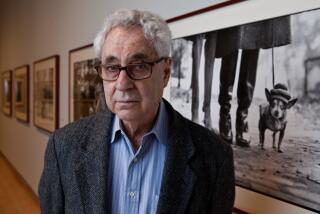Known for Shots of Hindenburg Disaster, Gehrig Farewell : Photographer Murray Becker Dies at 77
- Share via
Murray Becker, whose news photographs seared into America’s consciousness the individual tragedy of Lou Gehrig and the collective horror of the Hindenburg airship disaster, died Tuesday of cancer at his home in North Miami Beach, Fla.
Becker was 77 and had been retired from the Associated Press since 1972.
On May 6, 1937, Becker was 29 and had been with the wire service eight years. He was standing with a group of photographers at a mooring in Lakehurst, N.J., grumbling with his cohorts about the fading light as the pride of Adolf Hitler’s air fleet neared the end of its journey from Nazi Germany.
It was the 37th crossing of the Atlantic by the giant airship and the landings--much like manned space launches decades later--had become routine.
There were 97 people aboard the 803-foot, cigar-shaped ship which skimmed over the ocean at speeds of up to 90 m.p.h. Now they sat in stately comfort as the ship’s nose dropped so ground crews could wrap mooring lines around the mooring mast, snagging it to safety.
Suddenly an explosion ripped open the Hindenburg’s tail. The remainder of the dirigible was quickly enveloped. Next, Becker remembered, the tail touched the ground, forcing flaming hydrogen through the nose.
The following day his 15 pictures taken in 37 seconds reflected the carnage in newspapers around the world. As he took them he remembered murmuring “My God, My God,” for the 36 who died.
And afterward--when his film was headed for the darkroom at nearby Newark--he also remembered how he sat down and cried.
The tragic drama was to prove the end for dirigibles.
Within two years Becker had recorded another scene that has transcended time. This was at Yankee Stadium on July 4, 1939, when a dying Lou Gehrig made a farewell appearance before his teammates and 60,000 fans.
He had been stricken with amyotrophic lateral sclerosis, an incurable disease of the nervous system that would later bear his name.
As the Yankee first baseman poured out a few simple words--ending with “. . . this is the happiest day of my life”--words that were to prove his last public statement--he reached up to wipe away tears.
Becker had his 4-by-5 Speed Graphic (a large twin-lens view camera) ready.
His photograph became the prototype for Gary Cooper’s fade-away shot when he portrayed Gehrig in the highly acclaimed film “The Pride of the Yankees” three years later.
Later Becker was to pioneer picture coverage of the U.S. space program and helped develop the use of overhead and sequence cameras for sports and news coverage.
Through the years, he photographed and supervised coverage of political conventions, presidential inaugurations and major sports events while teaching at the University of North Carolina.
On Wednesday, Hal Buell, the AP’s assistant manager for news photos, said:
“Murray Becker took AP from the 4-by-5 era into 35-millimeter photography. He was a fine photographer, a gentleman and made an indelible mark on wire service photography.”
More to Read
Sign up for Essential California
The most important California stories and recommendations in your inbox every morning.
You may occasionally receive promotional content from the Los Angeles Times.












